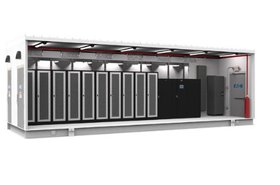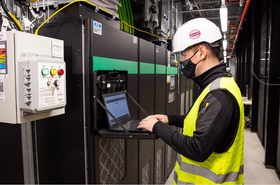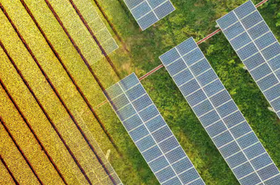Climate change: a planetary issue that affects us all. But with data centers now consuming ever increasing amounts of the world’s power, there is a certain moral obligation for the industry to act – not to mention the soaring demand for sustainable solutions at both a corporate and customer level.
Data centers are the lifeblood of the digital economy; intelligent management of energy, power and cooling is as critical as the management of the infrastructure that sits inside them. A recent research report by S&P Global Market Intelligence, commissioned by Eaton, ‘The intersection of digital transformation and the energy transition’, revealed some of the factors guiding the efficiency and sustainability efforts of data centers today, with several coming to the forefront as most important.
Fifty percent of data center respondents cited the need to increase renewables, followed by improving energy storage (47 percent), providing power intelligence insights to more people ‒ from technicians to the c-suite (41 percent), and promoting that story to regulators, markets and customers (40 percent).
It’s clear from the findings that in order to ensure our increasingly digital world is a sustainable one, data center operators must recognize that changes need to be made and that new energy business models will be key to how data centers view and manage their power needs. Afterall, the definition of insanity is doing the same thing over and over and expecting different results, or so said Albert Einstein.
That same sentiment is shared by Ciarán Forde, data center and IT market segment lead for Eaton’s electrical sector, EMEA. Forde is of the opinion that to meet both performance and sustainability goals, when it comes to data center design and build, the status quo has to change.
“Our lives are becoming increasingly digitized, and the energy required to achieve this is only going to rise as various systems move to an electrified platform. If we want to enjoy the benefits of a digital society and economy, there is an energy price that has to be paid.
“The penny has dropped that we don’t want to pay that price with fossil fuel. We want all the energy we need for a digital economy, but now, we want that energy to be green. In order to facilitate the onboarding of renewable energy, how you design and operate a data center will need to change.”
The good news is that by 2050, The International Renewable Energy Agency (IRENA) estimates that 90 percent of the world's electricity can and should come from renewable energy. The bad news however, is the intermittent nature of renewable energy poses flexibility challenges not only to data centers, but the energy grid itself.
“Grid systems do not exist today capable of accommodating such high levels of renewable energy,” says Forde. “I go back to August 2019 when there was a severe blackout and brownout in the UK because two sites, one of which an offshore wind farm, went off grid. It just brings home how much we take energy for granted.”
And all it takes is a large spike in consumption or drop in production to severely destabilize the grid. For that reason, a data center can’t just blindly consume renewable energy and say ‘job done’. A challenge faced by the grid operator is a challenge faced by us all, particularly those operating mission critical facilities.
“We have to go from being a blind consumer to a good grid citizen,” says Forde. “We have to ask, how do we perform on and what is our relationship to the grid?”
For this change to be realized, data center operators – alongside other large energy consumers – need an understanding of the energy coming in so they can use their own facilities to help optimize grid performance.
“When a data center operator’s biggest risk and cost is grid failure, then it’s in their best interest to help ensure a renewable grid that is more stable and doesn’t fail. With possibilities for the data center to participate in grid services, their contribution could help to make this happen,” says Forde.
To make said contribution possible, data center designers now have different parameters to factor in than they did previously.
“There have been some significant advances in terms of data centre policy related to energy efficiency and their relationship with energy generation and the grid.
“For example, there have been moratoriums on data center building in Frankfurt, Amsterdam and more recently Ireland, whereby new policy indicates a preference for data centers have onsite generation or to be located near sources of renewable generation.
“In many ways, a data center campus can be like a mini power plant in itself, covering its own load, as well as having dispatchable power to help stabilize the grid,” says Forde. “So entirely different concepts in terms of data center design, build and operation.”
This kind of proactive participation in the energy challenge would not only benefit the grid and in turn the wider world, but would help transition data centers from their previous status as part of the energy problem, to part of the solution, as well as a potential catalyst for a fully renewable grid in the future.
“Data centers are a technical and economic catalyst to the onboarding of renewables and the technology that goes with it. So instead of just 30 percent renewables on our grid, we could get up to 50, 60, 70 percent or even higher. So, with the support of the data center industry and others, we now have a mechanism to reach renewables at that level,” says Forde.
The services in which data centers can offer the grid vary, from energy generation and export, to storage and frequency containment.
The two main services operators can get on board with are frequency containment i.e., active power reserves that are automatically controlled based on deviations in grid frequency, and/or dispatchable power – sources of electricity that can be programmed on demand at the request of power grid operators.
Having had access to grid-interactive UPS systems since 2014, Eaton customers are already geared up for frequency containment, but for everyone else, small supplemental modifications to existing infrastructure may be required. This can be achieved via a power aggregator to help them deliver some of those frequency containment services, explains Forde.
When it comes to dispatchable power, however, many data centers would need to look at a redesign, and although challenging, should be seen as an opportunity to take the steps needed to realize a more sustainable future.
“A redesign can be very economically taken on board, because so many data centers are looking to remove their diesel gensets. So, as they move away from diesel backup power systems, the investment in the alternative can be grid-interactive and grid friendly,” says Forde.
Whether these alternatives are an enhanced UPS infrastructure with extended battery systems (for example Eaton EnergyAware), hydrogen fuel cells, storage systems (such as Eaton xStorage) or any other modern more sustainable form of backup power, once factored into the design, they are perfectly positioned to help deliver that grid-interactive supply.
What’s more, utilizing existing assets to provide services to the grid, operators avoid having to heavily invest in flexible storage systems, reducing capital expenditure and as a result, reducing the cost of energy along with it. A win-win for all involved.
And it’s not just about the hardware. As mentioned earlier, in order to be able to facilitate sustainable changes, data center operators need an understanding of the complex energy flows that are to be managed in a grid-interactive data center.
Enter, software.
“Software is key. It not only provides intelligent operational insights and actionable data but brings policy-based elements of automation and control. Working with a company like Eaton, you can design your data center to be interactive and green grid friendly. This also eases the management burden of the data center operators so they can focus on running their facility,” explains Forde.
Eaton is currently extending the capabilities of its own Brightlayer™ Data Centers suite software, so that it understands how to best manage that grid-interactive functionality.
Effectively rolling Data Center Infrastructure Management (DCIM) and Electrical Power Management System (EPMS) into one digital platform, Brightlayer provides 3D monitoring of the entire data center environment, pulling in data from all essential assets within the facility. This gives operators clear visibility and insights into their critical functions and operational data sets, enabling them to increase levels of control and automation.
“In many ways it’s like a data center operating system, but we’re incorporating elements of automation so operators can easily set policies and thresholds. They can access the kind of dashboard functionality required which will ultimately act as the vehicle to achieving greener grid-interactive systems,” says Forde.
So, if the technology is available today, complete with a raft of benefits across the board, why is the data center industry so slow on the uptake?
Unfortunately, that’s all down to our mindset. Human beings – particularly those that operate mission-critical data centers – don’t like needless change, despite the variety of technology available to them and are reluctant to use any part of their facility for anything other than protecting and operating the IT load. And therein lies the challenge.
“That is the mindset that has to change. If an operator wants a truly green data center, they must consider that it can only be realized by the creation of a green grid, so it is in their best interest as a business owner and operator to make this happen.
"If they can use their facility to increase the percentage of renewables on the grid from, say, 50 to 60 percent, that act is far greater than any efficiency they’d be able to achieve in a data center alone,” says Forde.
And many companies are on the quest for carbon neutrality, or even carbon negativity, but if they aren’t generating all the electricity they use themselves, they will always be reliant on what comes through the grid.
“There is only so much you can do within the four walls of a data center to be considered green,” says Forde. “You could have your PUE down to one, be one hundred percent efficient in terms of electricity, heat and water usage, but you’re still consuming energy, there is still embodied carbon in your facility. How can you truly be sustainable and reach net zero when this is the reality?
However, it is possible. But for these facilities to reach their full potential as the vanguards of green energy, we have to change our way of thinking. Yes, we all want green data centers, but in order to green the data center, you have to green the grid.
To learn more about Eaton’s Brightlayer Data Centers suite and/or EnergyAware grid-interactive UPS visit their website linked above. Talk with one of their experts today about how Eaton can help you achieve your energy transition goals.
More from Eaton
-

Going beyond the grey area with Eaton’s xModular
A new approach to delivering data center power infrastructure for ease of deployment, scalability and sustainability
-

Sponsored How data centers will support renewable power adoption
Pledging support for renewable power is one thing, but properly making the shift is quite another, says Eaton’s Janne Paananen and Ehsan Nasr
-

Microsoft teams up with Eaton for 'grid-interactive' UPS at Dublin data center
As Ireland grows increasingly hostile to data centers due to grid concerns

